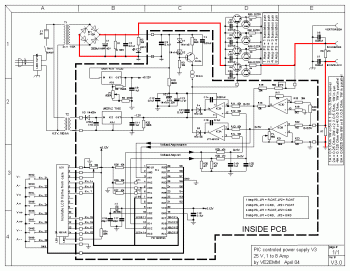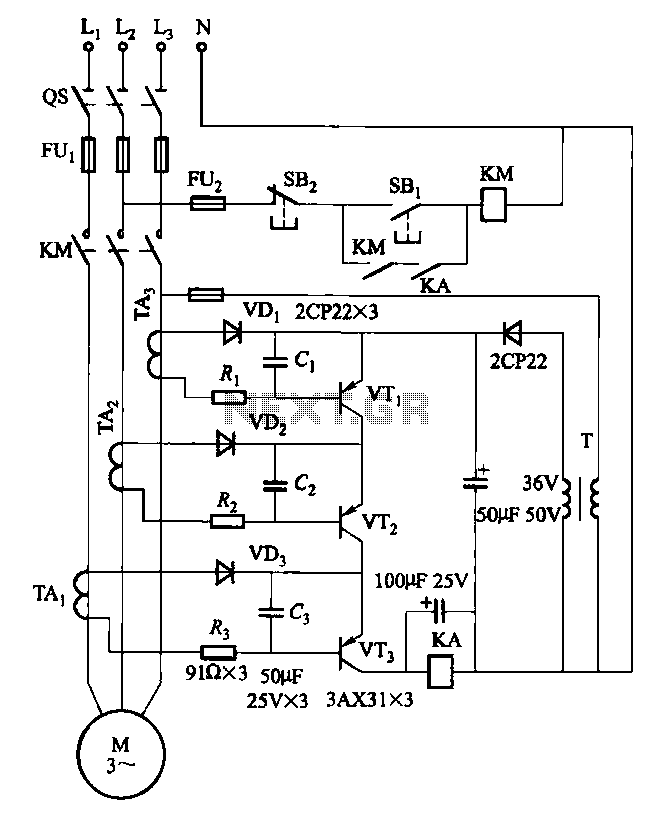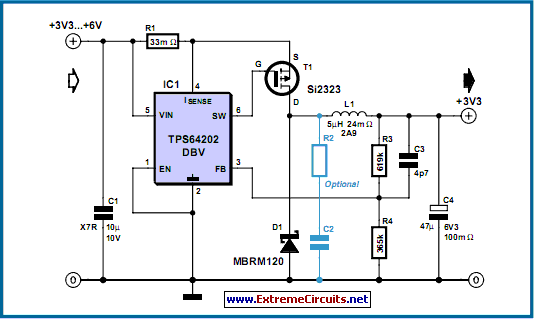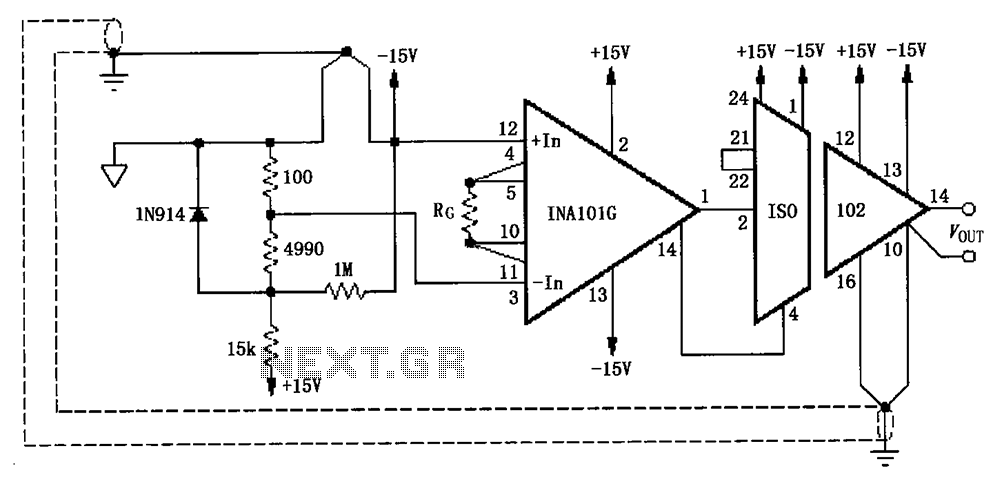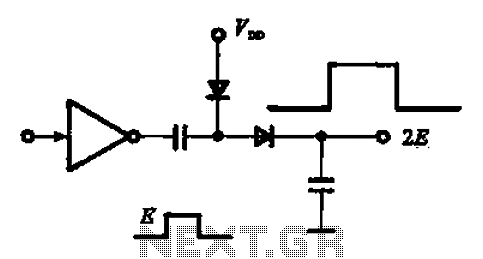
IR Remote Control Extender Circuit
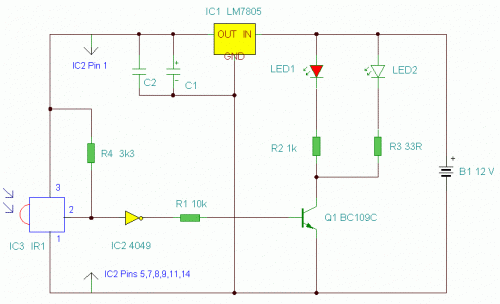
This is an enhanced infrared (IR) remote control extender circuit. It features high noise immunity, resistance to ambient and reflected light, and an extended range of approximately 7 meters from the remote control to the extender circuit. It is compatible with any domestic devices that operate at a 36-38 kHz IR carrier frequency. However, it is not compatible with some satellite receivers that utilize a 115 kHz carrier frequency. The primary distinction between this version and the previous circuit is the use of a commercially available infrared module. This module, designated as IR1, is obtainable from Harrison Electronics in the UK. The IR module comprises a built-in photodiode, amplifier circuit, buffer, and decoder. It is centered on the common 38 kHz carrier frequency used by most IR controls. The module filters out most of the carrier signal, allowing decoded pulses to be transmitted to the appliance. Domestic televisions and VCRs employ additional filtering to eliminate the carrier completely. The IR1 module is housed in a compact aluminum case, with its connections visible from underneath. The IR1 module (IC3) operates on 5 volts DC, supplied by the 7805 voltage regulator (IC1). In quiescent conditions (no IR signal), the output pin voltage remains high, around 5 volts DC. This output needs to be inverted and buffered to drive the IR photo emitter LED (LED2). The buffering is accomplished using one gate (pins 2 & 3) of a hex inverter, the CMOS 4049 (IC2). The IR1 module can directly drive TTL logic, but a pull-up resistor (R4) is necessary for interfacing with CMOS ICs. This resistor ensures that the signal from a remote control alternates between 0 and 5 volts. Since TTL logic levels differ slightly from CMOS, the 3.3 kΩ resistor (R4) is connected to the 5-volt supply line, ensuring that the logic high signal reaches 5 volts instead of the TTL levels of 3.3 volts. The resistor does not impact the performance of the IR module but ensures stable driving of the CMOS buffer. The output from pin 2 of the 4049 directly drives transistor Q1, with a 10 kΩ resistor (R1) limiting the base current. LED1, a red LED, flickers to indicate when a signal from a remote control is received. It is important to note that, in this circuit, the carrier is still present, albeit at a reduced level, along with the decoded IR signal. The CMOS 4049 and BC109C transistor amplify both the carrier and the signal, driving LED2 with a peak current of approximately 120 mA when a signal is detected. Measurement with a digital meter may show a lower value, around 30 mA, as the meter reads the average DC value rather than the peak current. Any equipment designed to operate between 36 and 40 kHz should function correctly; however, controls with carrier frequencies outside this range may have reduced effectiveness. The exception is that certain satellite receivers have IR controls using a higher modulated carrier of approximately 115 kHz, which are currently incompatible with this circuit. A Mark 3 version is in development to reintroduce support for these higher carrier frequencies.
The circuit's design leverages the capabilities of the IR module to enhance the functionality of remote controls in various domestic appliances. The use of the 7805 voltage regulator ensures stable power supply conditions, while the CMOS 4049 inverter provides necessary signal conditioning. The incorporation of R4 as a pull-up resistor is critical for proper interfacing with CMOS logic, ensuring reliable operation across different devices. The choice of the BC109C transistor allows for sufficient amplification of the signals to drive the IR emitter effectively. This circuit is particularly valuable in environments with high ambient light interference, making it a practical solution for extending the reach of IR remote controls in home entertainment systems.This is an improved IR remote control extender circuit. It has high noise immunity, is resistant to ambient and reflected light and has an increased range from remote control to the extender circuit of about 7 meters. It should work with any domestic apparatus that use 36-38kHz for the IR carrier frequency. Please note that this is NOT compatible with some satellite receivers that use 115KHz as a carrier frequency. The main difference between this version and the previous circuit, is that this design uses a commercially available Infra Red module. This module, part number IR1 is available from Harrison Electronics in the UK. The IR module contains a built in photo diode, amplifier circuit and buffer and decoder. It is centerd on the common 38kHz carrier frequency that most IR controls use. The module removes most of the carrier allowing decoded pulses to pass to the appliance. Domestic TV`s and VCR`s use extra filtering is used to completely remove the carrier. The IR1 is packaged in a small aluminium case, the connections viewed from underneath are shown below: The IR1 module (IC3) operates on 5 Volt dc.
This is provided by the 7805 voltage regulator, IC1. Under quiescent (no IR signal) conditions the voltage on the output pin is high, around 5 volts dc. This needs to be inverted and buffered to drive the IR photo emitter LED, LED2. The buffering is provided by one gate (pins 2 & 3) of a hex invertor the CMOS 4049, IC2. The IR1 module can directly drive TTL logic, but a pull-up resistor, R4 is required to interface to CMOS IC`s. This resistor ensures that the signal from a remote control will alternate between 0 and 5 volts. As TTL logic levels are slightly different from CMOS, the 3. 3k resistor R4 is wired to the 5 volt supply line ensuring that the logic high signal will be 5 volts and not the TTL levels 3.
3 volts. The resistor does not affect performance of the IR module, but DOES ensure that the module will correctly drive the CMOS buffer without instability. The output from the 4049 pin 2 directly drives transistor Q1, the 10k resistor R1 limiting base current.
LED1 is a RED LED, it will flicker to indicate when a signal from a remote control is received. Note that in this circuit, the carrier is still present, but at a reduced level, as well as the decoded IR signal. The CMOS 4049 and BC109C transistor will amplify both carrier and signal driving LED2 at a peak current of about 120 mA when a signal is received.
If you try to measure this with a digital meter, it will read much less, probably around 30mA as the meter will measure the average DC value, not the peak current. Any equipment designed to work between 36 and 40kHz should work, any controls with carrier frequencies outside this limit will have reduced range, but should work.
The exception here is that some satellite receivers have IR controls that use a higher modulated carrier of around 115KHz. At present, these DO NOT work with my circuit, however I am working on a Mark 3 version to re-introduce the carrier.
🔗 External reference
The circuit's design leverages the capabilities of the IR module to enhance the functionality of remote controls in various domestic appliances. The use of the 7805 voltage regulator ensures stable power supply conditions, while the CMOS 4049 inverter provides necessary signal conditioning. The incorporation of R4 as a pull-up resistor is critical for proper interfacing with CMOS logic, ensuring reliable operation across different devices. The choice of the BC109C transistor allows for sufficient amplification of the signals to drive the IR emitter effectively. This circuit is particularly valuable in environments with high ambient light interference, making it a practical solution for extending the reach of IR remote controls in home entertainment systems.This is an improved IR remote control extender circuit. It has high noise immunity, is resistant to ambient and reflected light and has an increased range from remote control to the extender circuit of about 7 meters. It should work with any domestic apparatus that use 36-38kHz for the IR carrier frequency. Please note that this is NOT compatible with some satellite receivers that use 115KHz as a carrier frequency. The main difference between this version and the previous circuit, is that this design uses a commercially available Infra Red module. This module, part number IR1 is available from Harrison Electronics in the UK. The IR module contains a built in photo diode, amplifier circuit and buffer and decoder. It is centerd on the common 38kHz carrier frequency that most IR controls use. The module removes most of the carrier allowing decoded pulses to pass to the appliance. Domestic TV`s and VCR`s use extra filtering is used to completely remove the carrier. The IR1 is packaged in a small aluminium case, the connections viewed from underneath are shown below: The IR1 module (IC3) operates on 5 Volt dc.
This is provided by the 7805 voltage regulator, IC1. Under quiescent (no IR signal) conditions the voltage on the output pin is high, around 5 volts dc. This needs to be inverted and buffered to drive the IR photo emitter LED, LED2. The buffering is provided by one gate (pins 2 & 3) of a hex invertor the CMOS 4049, IC2. The IR1 module can directly drive TTL logic, but a pull-up resistor, R4 is required to interface to CMOS IC`s. This resistor ensures that the signal from a remote control will alternate between 0 and 5 volts. As TTL logic levels are slightly different from CMOS, the 3. 3k resistor R4 is wired to the 5 volt supply line ensuring that the logic high signal will be 5 volts and not the TTL levels 3.
3 volts. The resistor does not affect performance of the IR module, but DOES ensure that the module will correctly drive the CMOS buffer without instability. The output from the 4049 pin 2 directly drives transistor Q1, the 10k resistor R1 limiting base current.
LED1 is a RED LED, it will flicker to indicate when a signal from a remote control is received. Note that in this circuit, the carrier is still present, but at a reduced level, as well as the decoded IR signal. The CMOS 4049 and BC109C transistor will amplify both carrier and signal driving LED2 at a peak current of about 120 mA when a signal is received.
If you try to measure this with a digital meter, it will read much less, probably around 30mA as the meter will measure the average DC value, not the peak current. Any equipment designed to work between 36 and 40kHz should work, any controls with carrier frequencies outside this limit will have reduced range, but should work.
The exception here is that some satellite receivers have IR controls that use a higher modulated carrier of around 115KHz. At present, these DO NOT work with my circuit, however I am working on a Mark 3 version to re-introduce the carrier.
🔗 External reference
